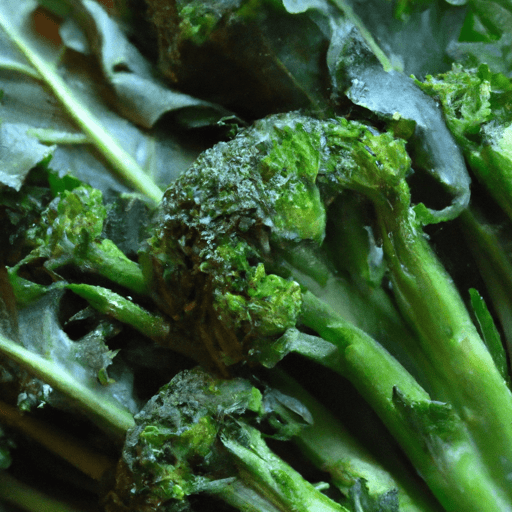Exploring the World of Broccoli Raab: A Delightful Green Vegetable
Broccoli raab, also known as rapini or broccoli rabe, is a vibrant and versatile vegetable that has gained popularity in the culinary world. With its distinct flavor profile and numerous health benefits, this leafy green is an excellent choice to incorporate into your cooking repertoire. In this blog post, we will dive into the world of broccoli raab, exploring its taste, common uses, nutritional value, and fascinating history.
The Taste of Broccoli Raab
When it comes to flavor, broccoli raab offers a unique and slightly bitter taste, with hints of nuttiness. Its robust and earthy flavor is often compared to broccoli, but with a more assertive and intense profile. This bitterness mellows when cooked, developing a delectable balance of flavors that delight the taste buds.
Utilizing Broccoli Raab in the Kitchen
Broccoli raab can be a versatile addition to your culinary creations. From pasta dishes to stir-fries, soups to frittatas, this green vegetable adds depth and vibrancy to a variety of dishes. Here are a few popular ways to enjoy its distinctive taste and texture:
1. Pasta Delight:
Sauteed with garlic and chili flakes, broccoli raab serves as a delightful companion to pasta dishes. Toss it with al dente spaghetti, sprinkle with Parmesan cheese, and you have a simple, yet satisfying meal.
2. Stir-Fry Sensation:
In stir-fries, broccoli raab adds a unique twist. A quick stir in a hot pan with sesame oil, soy sauce, and your choice of protein creates a flavorful and nutritious meal in minutes.
3. Leafy Soup Goodness:
Simmer broccoli raab in a rich vegetable or chicken broth, and you’ll have a comforting and nourishing soup. Enhance it with your favorite herbs and spices for an added kick.
4. Frittata Fantastic:
Broccoli raab pairs exceptionally well with eggs in a frittata. Saute it with some onions, combine with beaten eggs, and bake until golden brown. The result? A flavorful and hearty dish suitable for any time of the day.
Nutritional Value of Broccoli Raab
In addition to its wonderful taste, broccoli raab offers an array of health benefits. This leafy green vegetable is packed with essential nutrients, making it a wise choice for those seeking a wholesome and balanced diet. Here are some notable nutritional highlights:
Vitamin C: Broccoli raab is a rich source of vitamin C, a powerful antioxidant that supports immune health and collagen production.
Vitamin K: Known for its role in blood clotting and bone health, vitamin K can be found in abundance in broccoli raab.
Fiber: Incorporating fiber into your diet is important for digestive health, and broccoli raab provides a good amount of dietary fiber.
Iron: This leafy green vegetable is a great source of iron, which is vital for carrying oxygen throughout the body and preventing fatigue.
A Glimpse into Broccoli Raab’s Fascinating History
While broccoli raab may seem like a modern-day discovery, it has actually been enjoyed for centuries. Originating in the Mediterranean region, this vegetable has been a staple in Italian cuisine since the Roman Empire. Traditionally, it was favored in Italian-American communities, and its popularity has now spread far and wide.
Explore the Versatility of Broccoli Raab
Broccoli raab’s distinctive flavor, versatility in the kitchen, and impressive nutritional profile make it an excellent choice for food enthusiasts and health-conscious individuals alike. Whether you’re a seasoned cook or just starting to explore the world of vegetables, don’t miss the opportunity to experiment with this vibrant and delicious green.
So, next time you’re planning your meals, consider adding broccoli raab to your grocery list. Embrace its unique taste, experiment with various recipes, and embark on a culinary journey that celebrates the wonders of this remarkable vegetable.
Broccoli Raab
Origin: Broccoli raab, also known as rapini or broccoli rabe, is a vegetable that comes from the Brassica family, which includes cabbage, kale, and broccoli. It is believed to have originated in the Mediterranean region, specifically in the vicinity of Italy and China.
Common Uses: Broccoli raab is commonly used in Italian and Chinese cuisines. It has a distinctive bitter taste and tender texture. It is often stir-fried, sautéed, or blanched and added to pastas, risottos, soups, and salads. Some popular Italian dishes that feature broccoli raab include orecchiette pasta with sausage and broccoli raab, as well as broccoli raab with garlic and olive oil.
Nutritional Benefits: Broccoli raab is highly nutritious and is rich in vitamins A, C, and K. It is also a good source of calcium, iron, and fiber. It is low in calories and contains beneficial antioxidants. Consuming broccoli raab can help support healthy bones and teeth, boost the immune system, and promote heart health.
Unique Properties: Unlike traditional broccoli, which has a tight head and large florets, broccoli raab has small florets with long, thin stems and leaves. The leaves and stems of broccoli raab are edible and have a slightly spicy, bitter flavor. The entire plant is harvested and consumed, including the florets, stems, and leaves.
Historical Significance: Broccoli raab has been cultivated for centuries and has a long history in both Italian and Chinese cuisines. In Italy, it is commonly paired with sausage in traditional pasta dishes. In China, it is often used in stir-fries and noodle dishes. Over time, broccoli raab has gained popularity in other parts of the world due to its unique taste and versatility in cooking.




Use the share button below if you liked it.
It makes me smile, when I see it.